ビルマ(ミャンマー)戦場をめざすフリーター2007年7月
カレン民族同盟の義勇兵を志す
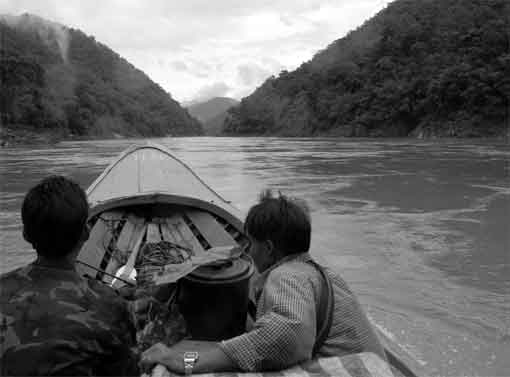
「楽しみのために行くんですよ。ボランティアとか、自分、そんな言葉、大嫌いっすから」。照れ隠しなのだろうか、大谷敬一さん=仮名(37)は今年の夏、そんな風に言ってバンコク行きの飛行機に乗った。彼はミャンマー軍事独裁政権に抵抗するカレン民族同盟(KNU)の義勇兵になりたい、つまり、あえて紛争地へ乗り込んで行くという。「なぜ?」。KNUは往復の交通費も、危険手当も出せる財政状況にない。「自分の持っている技術や知識が、あそこなら役に立つと思うんで」。大谷さんはKNU兵たちに塹壕の掘り方や武器爆薬の使い方を教えたいと言っている。
ところで「ミャンマー」は軍政が議会や国民の承諾なしに変えた国名なので、以下、ビルマとする。ビルマにはシャンやチン、カチンなど135の少数民族がいるといわれ、カレン族は全人口の約7%を占め、ビルマ族に次いで多い。ビルマがイギリスから独立した1948年以来、カレン族は独立を主張してきたが、外国政府に承認されることもなく、地図にない国である。しかし、タイとの国境貿易や河川による水運業、また、木材の輸出などで、最盛期には財政規模が50億円ほどあり、学校や病院、裁判所、そして軍と国家の体裁を整えていた。
派遣労働で資金作り
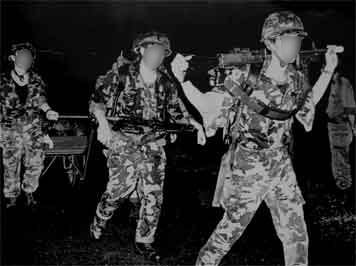
今年1月、大谷さんは現地を下見。帰国後は派遣労働者をして、カレン行きの資金、約70万円を作った。5月、三重県桑名市に彼を訪ねた。「自動車工場で一番大きなプレス機を担当してます。土日もアルバイトさせてもらって、資金作りの方は、まぁ順調ですね」。派遣会社が借り上げるアパートに住み、工場の食堂は高いと、自炊し、おかずは冷凍食品という弁当で倹約している。「死んだ時は死んだ時で、俺は別に死を恐れてませんし、長生きなんかした日には、その方が心配ですよ」
高校を中退、ガソリンスタンドやカー用品店でアルバイトをした後、自衛隊に入り、福岡と千葉の部隊に計6年半いた。KNUの存在は自衛隊の座学で世界の紛争地の一つとして知り、興味を持ったのは、除隊後に働いた関東の警備会社にいたKNU義勇兵経験者の話に感銘を受けたからだという。その会社で社員にならないかという誘いもあったが、縛られるのが嫌で断ったという。「俺には、普通の人が持っているような将来の夢はないんです。それよりも、今を楽しく生きたい。そうじゃないと、毎日が砂を噛むような日々になりますから」
大谷さんはビルマへ旅立つ前、「あんまり勝手なことしてるんで、勘当されているんですけど」と言いながらも、2年ぶりに福岡県太宰府市の実家にふらり立ち寄った。定年まで自衛隊に勤めた父親が口を開いたのは記者が同行していたからだろうが、「マラリアに気をつけて、大いに活躍してもらいたいものです」と。両親は息子からこの日初めてカレン州行きを聞き、難民キャンプのボランティアにでも行くと思っている様子だ。母親は「結婚するまでは、好きなことをしていれば良いんじゃないか思ってます」。当の本人は、「カノジョができると、家庭がちらついたりするんでしょうが、結局いつも振られて、妻子はいません。母親には時々メールを送ったりしますけど、そんなこと考えていたら行けませんから」と。
旧日本兵との出会い
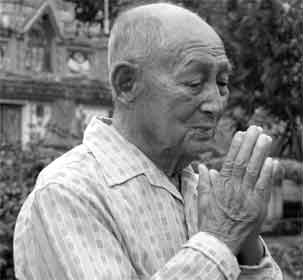
KNUは昨年末、ボーミャ前議長が病没し、求心力のある指導者を失った。1996年タイのウンパンで会ったボーミャ氏は政府軍の戦略を次のように分析していた。軍政はKNUの分裂弱体化を狙って、カレン族の仏教徒を優遇、カレン州の幹道沿いに寺院を建て、参拝客に工作員を紛れ込ませ、キリスト教徒のカレン族との宗教対立を煽った。その結果、KNUの仏教派が政府軍に投降。軍政は95年1月彼らを使ってKNUの総司令部、マナプローを陥落させたという。以来、カレン州はタイ国境まで政府軍の侵略を受け、カレン族はポーターや土木工事の強制労働、強制立ち退きに従わなければ殺されるという迫害に遭っている。
バンコクを経て大谷さんがやってきたのは、モエイ川を挟んでカレン州と接するタイの街、メソート。かつてKNU義勇兵となり戦病死した日本人青年3人を祀る『自由戦士の碑』がこの街にはある。攻防が激しかった90年代には、短期で一度だけという人も含めると10人以上の日本人がKNUに加勢した。その碑を世話しているのが、旧日本軍第31師団の衛生兵で、戦後もカレン州に残り、メソートに居を構えた中野弥一郎さん(87)。
「カレン人は英国側で敵だったのですが、終戦になると、離隊した私を匿ってくれたんです。ビルマ軍の中には居れなかったですよ」。日本軍の形勢が悪いと見ると、ビルマ軍は英国側に寝返り、日本兵狩りをしたそうだ。「それでカレン人と親しくしてきたわけです」。中野さんはカレン族の女性と結婚し、衛生兵の知識を活かして無医村に貢献。その後は、雑貨屋を手始めに、宝石貿易で成功した。しかし、中野さんがタイへ引っ越して来たのも、国軍が攻めてきて、カレン州には安住できなくなったからである。
中野さんは62年前、軍の命令でカレン州に送り込まれてきた。大谷さんのように自ら志願してKNUの義勇兵になる今の日本人の若者を、中野さんは「大変、偉いことだと思います」と言うが、一方で「日本にいれば、何の不自由もなく、自衛隊にいても安穏と暮らせるのに、他人様の国のために、ここまでお出でになるというのは、私にも分かりません」と。
KNU(カレン民族同盟)のその後
メソートにはKNUのいわば大使館に相当する連絡事務所もある。大谷さんは出発前に日本のKNU支援者から受け入れ窓口は武官のアロー氏だと言われていた。だが、大谷さんはタイ側の事務所いる幹部たちを毛嫌いして接触を避け、下見の際に知り合ったイゴーさん(24)の案内で独自に前線へ行こうと考えていた。イゴーさんは所属していたKNU第七旅団が崩壊して、難民になった一人。目的地デボノがあるカレン州北部の出身で、英語が少しできる彼は頼みの綱だ。大谷さんはアロー氏が示した現地入り経費の使途が不明瞭だと、加えて、前線で戦っているKNU兵とかけ離れたアロー氏の贅沢な暮らしぶりから、横領を疑っているのである。イゴーさんは「安全を確保するために、タイの入管なんかに払っているんだよ」と説明するが、大谷さんは「アロー氏はボート代やガイドに払うとは言ったが、タイへとは言わなかった」と納得がいかないようだ。KNUはタイ領内に拠点を置いて第三国と連絡し、軍政と交渉し、また、商人や労働者が国境を往き来できるといった慣例を維持してきた。もしタイ当局が厳しく取り締まれば、大谷さんの越境も問題とされよう。
一方、軍政との和平交渉は頓挫したままだ。タイ・ビルマを結ぶアジアハイウェー沿いの一軒家に設けられている『平和のためのKNU連絡事務所』で、停戦協議にも臨席してきたナイ・ソー大佐(64)に会った。1995年10月にメソートで開かれた初会合以来、軍政は一貫して自分たちが合法政府で、KNUは非合法組織と決めつけ、独立を認めず、武装解除を求めている。それに対してKNUは、自州に国軍が入ってくることを拒み、非武装緩衝地帯を作って完全停戦することを提案してきた。だが、一連の和平会談は97年1月末で頓挫し、翌2月には再び交戦状態となった。
軍政は2003年11月バンコク経由で大佐と大使館員を送り込み、翌12月にはナイ・ソー氏を含む4人のKNU交渉団がヤンゴンに赴き、キンニュン首相(当時)に改めて停戦を訴えた。翌04年1月ついにボーミャ議長がヤンゴン入り、(1)完全停戦、(2)難民の自村への帰還、(3)会議の継続、(4)両側にモニターグループを付ける、という条件を挙げた。しかし、キンニュン氏は全く譲歩せず、逆に、タイ・カンチャナブリ北方など3地域へのカレン族移住案を持ち帰らせた。キンニュン首相は同年10月に更迭され、交渉は05年5月にメソートの対岸、ミャワディーで持たれたのを最後に開かれていない。「なんの保障もない和平条約は、到底受け容れられません」。そう言って握りしめたソー大佐の右手には『コーカレー(=カレン国の首都)のために』と刺青が彫られていた。
KNUは北のトンウー、南はマリトワイまで7つの旅団、約2万人の兵力を保っていると今も誇示する。確かに90年代前半までは、メソートの西側も、南のスリーパゴダパスの向こう側も、KNUが抑えるカレン州だった。だが、現実は国軍に侵略され、国境のモエイ川に架かっていた竹製の橋や河岸の市場や製材所は跡形もなく消え、不気味なまでに静まり返っている。07年夏現在、KNUの解放区が残るのは、実質、第5旅団が辛うじて武力抵抗している州北部のみ。「国内に踏み留まって、自分たちの土地を守っている人たちを助けたい」という大谷さんは、そこを目指しているのである。
「難民は嫌いです」
その管区へはメソートから陸路で200キロほど北上し、さらにサロウィン川を4時間余り遡るという行程だ。大谷さんはイゴーさんと二人、メソートからピックアップを改造した乗り合いバスに乗った。イゴーさんはメソートにある難民支援の外国NGOでアルバイトをしているのだが、それを欠勤して、大谷さんに同行している。戻ったときに、これまで通り働けるかどうかが不安だ。さらに、タイ国境警備警察の検問所は、タイ国内の移動を禁じられている難民のイゴーさんにとっては鬼門。数キロ手前で下車し、ジャングルの中を迂回、検問所を過ぎた所で次のバスに再び乗らなければならない。
メソートから1時間も走ると、道路と国境に挟まれた丘にびっしりと小屋が建つ偉容な風景が現れた。メーラ難民キャンプである。軍政の迫害や攻撃から逃れてきたビルマ難民はタイの9カ所のキャンプに約14万人いるが、そのなかでもここは最大で、カレン族を中心に4万9千人が暮らす。イゴーさんの知り合いや親戚も住んでいるのだが、大谷さんは露骨に言う。「僕は難民が嫌いです。ここに居たら喰うのには困りませんから、彼らに自尊自立の気持ちが残っているか、残っていないでしょうね。カネ欲しいだの、外国へ行きたいだの、腐っちまってますよ。僕は国内に残って、非戦闘員でも畑をしたりして、KNUを支えている人が本来の姿だと思いますから」
タイ国境に追い詰められ、難民となったカレン族たちはピークだった90年の約20万人から、6万人ほど減っている。だが、それは軍政に投降したり、タイで不法労働者になったり、タイの市民権を取ったり、或いは第三国へ定住したりしたからであって、状況が好転したのではない。KNUはもう60年間闘ってきたが、軍政は民主派が大勝した90年の総選挙も反故にし、カレン州の独立という目標は遠くなる一方だ。今年2月にもKNU第7旅団のティンモン司令官が部下とその家族を連れ投降している。 キャンプを出ると、大型バス2台に乗り込む行列に出くわした。アメリカへ旅立つ難民たちだ。同行するイゴーさんに将来の夢を訊く。「僕には妻子がいるし、子供は自由な国で育てたいよ、分かるだろ」と、オーストラリアへの定住を望んでいることを明かした。
「NO DAM!」
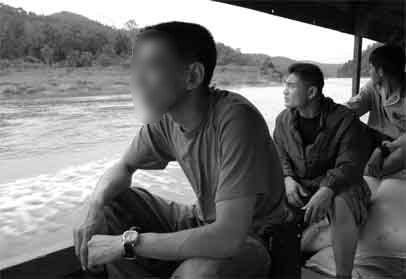
いよいよビルマ・カレン州に入る。昨夜は北タイの地方都市、メーサリアンにあるイゴーさんの親戚宅に泊まり、朝早く車で30分ほど走って、サロウィン川の港町、メーサムレップにやってきた。対岸はカレン州。上流はカレニー州、シャン州へと続く。船着き場へ降りる階段脇にはタイ入管の小屋がある。大谷さんは大きな荷物を別行動のポーターに託して、観光客を装う。確かに、この辺りはタイの国立自然公園に指定されている。「ダメだったら、闇夜に紛れて渡りますから」と開き直るが、緊張の一瞬である。備え付けのノートにボールペンで氏名を自筆し、職員にデジタルカメラで写真を撮られた。しかし、パスポートとの照合も、手荷物検査もない。「夕方5時までに戻って来るように」。入管職員はそれだけ言って、通してくれた。船頭は「彼らは5時で引き揚げるからですよ」と、入管は夜間、無人になると教えてくれた。
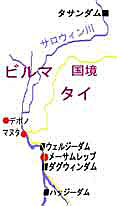
ここからは、ボート。全長7~8メートル、幅は2メートル足らずの細長い木造船には、テントの屋根と自動車用エンジンが付いている。轟音はすさまじいが、時速30キロくらいで滑るように進む。川沿いの急峻なジャングルに部落が点在する。政府軍に村を追われた国内避難民の家々だ。こんな急斜面では米作は不可能。ボートは路線バスのように、部落に寄っては、町帰りの住民と援助米の袋を降ろしていく。
V字谷に川が狭くなり、岩礁や早瀬が現れる。「あそこ!ほらっ」とイゴーさんが指さす岸には、『NO DAM!(ダム反対!)』という看板が建っている。NOの「O」は髑髏のイラストになっている。写真を撮ろうとする大谷氏に、船頭がスピードを落とした。ここが『サロウィン川ダム開発』の一つ、ウェルジーダム建設予定地である。 ビルマ軍政はタイと中国の民間資本との間でダム開発事業に調印。計画されている5つの発電ダムのうち、先に軍政に投降したシャン族のシャン州内でタサンダム(7,110MW)が今年4月着工された。他の4つのダム予定地はカレン州内にあり、今年11月から工事が始まるという情報だ。
カレン族は自衛のために、国軍が重火器を持ち込めぬよう、あえて道路を整備してこなかった。だから、川が交通運輸の大動脈であり、軍政によるダム建設は、KNUにとって生命線を絶たれることになる。 メソートでの夜、大谷さんはイゴーさんにこう語っていた。「今回、俺はハッジーへ行きたい。カレン州で最初に着工されるダムだから。俺は計画を破綻させたいんだ」。ところどころ測量の黄色いペンキが付いている岩礁をすり抜け、ボートは遡上する。行く手のジャングルに水煙が上ったかと思うと、スコールがボートを襲う。大谷さんは舳先へ向かう。乗り合わせた民族衣装の母子がずぶ濡れになる前に、彼は自分のポンチョを貸した。
統制がとれていたKNU
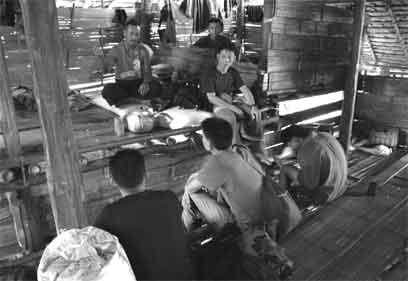
メーサムレップを出発して約4時間、KNU第5旅団管区の玄関に当たるマヌタ村に着いた。KNUは大谷さん来訪の連絡を受けていたようで、イラ隊長(45)が川岸まで降りてきていた。柱は木、壁と床は編んだ竹、屋根は木の葉で葺かれた高床式の家々が急斜面に軒を連ねる。以前は3、4軒だったこの村も、国内避難民で14軒に膨れあがったという。KNUの事務所には、袋に入った援助米と鳥撃ち用の銃。イラ隊長によると、マヌタ村駐屯の部隊は約1万人が住む10の集落を防衛していて、雨期でも戦闘は毎日のようにある。「西からは政府軍、東からはダム建設の外国が入ってきて、我々にどこで暮らせというのか」と、隊長は侵略への苛立ちを隠さない。電気がない村では、暗くならないうちに夕食を済ませる。炊事係の兵士が七輪に鍋を架けた。
イゴーさんの通訳に大谷さんの表情が冴えない。「デボノに行けない!それじゃ、カネを捨てたようなもんだ」。彼はデボノの第5旅団本隊と合流したいのだが、メソートで許可を取ってこなかったことが知れ渡っていた。「外国人がアロー氏の許可なしに入って、死んでしまうと大問題になるから」と、隊長は落ち着いた口調で説く。大使館や司令部の役目を果たしているメソートの事務所と前線部隊は、背水の陣に追い込まれた今も、きちんと統制が取れているということだ。前線での動きは、大事な外交カードとなるのだから、連携が取れていて当然である。過酷な前線に踏み止まっている兵士を直接支援したいという大谷さんの思いは、KNUが組織の体を成している限り無謀なようだった。
翌日デボノへ行くという兵士に、下見の時に意気投合した第5旅団のヘン将軍への伝言を託したが、その回答を村に泊まって待つことは許されない。「イゴーを『話が違うじゃないか!』と叱り飛ばして、『俺は独りでも行くからな!』って言おうかなとも、ちょっと考えたんですが、やっぱりここは丸く…。歳ですかね」。大谷さんは荷物を置かせてもらい、一旦タイへ戻ることにした。引き返す船で、再度「なぜ」を問う。「こういう生きるか死ぬかという状況に追い詰められている彼らだからこそ、俺みたいな日本では底辺のはみ出し者でも、受け入れてくれるんじゃないですか。マラリアで死ぬかも知れないけど、ここへ来ると『生きている!』って思えるんですよね。最高じゃないですか」。
平和の構図
ダム建設阻止の力になりたいという大谷さんは、最後に「有り体に言うと、テロリストになりますね、俺は」と発言した。その言葉が気になり、バンコクのチュラロンコン大学にスリチャイ・ワンゲオ准教授(56)=社会学専攻を訪ねた。サロウィン川のダム建設は不安要素を増やすと前置きした上で、彼は「世界中で格差が拡がり、その間の対話が少なくなっています。少数民族も日本のフリーターも、人権や生活において閉塞的な状況に追い込まれているのは、テロ防止という観点からも危ない。権力やカネを持っている人は、もっと彼らが自己実現できるような政策を考えるべきです」と危惧した。
少数民族を支援する日本人フリーターと、ビルマ軍事政権を承認している日本政府。テロの構図をもう一方から見れば、それは平和の構図である。大谷さんはその後、イゴーさんに迷惑がかからぬよう、カレン族の別の若者にガイドを頼み、デボノ入りを果たしている。
